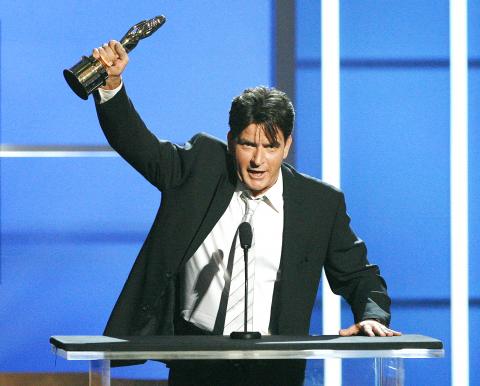His mantra of “winning” has taken the Internet by storm — more than 2 million people follow him on Twitter — but for Charlie Sheen, the obvious question is: has he completely lost the plot?
The troubled star’s sacking from the hit TV show Two and a Half Men on Monday came after the 45-year-old hurled himself into what Warner Brothers called his “self-inflicted disintegration” over the past two weeks.
In almost daily media outbursts he railed at his former bosses on the TV series, drawing accusations of anti-Semitism and mutterings that — like Mel Gibson before him — he would never work in Hollywood again.

Photo: Reuters
On Monday, Warner Bros Television announced his sacking “effective immediately,” while a lawyers’ letter referred to his “dangerously self-destructive conduct.”
“Now, the entire world knows Mr Sheen’s condition from his alarming outbursts over just the last few weeks,” it said, lamenting “the public spectacle of his self-inflicted disintegration.”
That spectacle has included repeated claims by Sheen that he is “winning,” because everyone else would love to have his life of money, women and drugs, and that his critics are just jealous losers, whose life he despises.
Public relations experts say that Sheen could still emerge victorious from his public relations crisis — partly by making money from his own online activities, including attracting sponsorship for his hugely-successful Twitter feed.
“Charlie wants to capitalize on his current fame and publicity as much as he can right now because the future is uncertain and because he’s without a job,” said public relations expert Dan Shawbel.
“He will leverage his Twitter feed, Ustream.com channel, and other online outlets to monetize his personal brand,” he added, referring to the live streaming show, Sheen’s Korner, which aired over the weekend on Ustream.com.
Another Hollywood public relations professional, Jerome Cleary, added: “If I was Charlie Sheen I would immediately do a deal for a reality show to begin filming this week with E! or HBO or Showtime.
“I think Charlie is with it and happening and I think it’s great that he is using Twitter and UStream initiatives and I would encourage even more.”
Monday’s sacking could certainly be a turning point: Some had argued that Sheen was playing a clever game, pressing CBS to get a better deal — in one outburst last week he said wanted US$3 million an episode, up from US$2 million.
That is clearly no longer realistic. The TMZ celebrity Web site reported that Sheen would follow through on a threat to sue Two and a Half Men producer Chuck Lorre and Warner Brothers over his dismissal.
And it cited Sheen himself as saying: “This is very good news. It is a big day of gladness at the Sober Valley Lodge,” the ironic name he has given his home outside Los Angeles.
Whatever happens in the coming days, Sheen follows in a grand tradition of Hollywood stars going off the rails. Other recent examples include Mickey Rourke, Robert Downey Jr, Britney Spears, and Lindsay Lohan.
Gibson’s career has never recovered from a 2006 drunk driving incident in which he was reported to have made anti-Semitic remarks, fueling a slide that has also included allegations of domestic abuse.
One major difference, of course, is the explosion of social media.
In a world of Twitter, Facebook and easy ability to livestream anything you say or do, Sheen has the power to broadcast his own message, without the need for huge budgets, or the filter from traditional media.
Public relations expert Cleary said Sheen’s sacking from Two and a Half Men won’t necessarily be a bad thing.
“I do not think it adds to the damage because the public obviously loves it. He pushed Miley Cyrus, Lindsey and Britney right off the front pages and stole all of their thunder with his new vocabulary and zaniness,” he said.
“Charlie does not care and now the door is wide open for either reality TV or another TV show to grab him up. He’s talented, funny, provocative. I do not think Charlie cares if he gets fired.”

That US assistance was a model for Taiwan’s spectacular development success was early recognized by policymakers and analysts. In a report to the US Congress for the fiscal year 1962, former President John F. Kennedy noted Taiwan’s “rapid economic growth,” was “producing a substantial net gain in living.” Kennedy had a stake in Taiwan’s achievements and the US’ official development assistance (ODA) in general: In September 1961, his entreaty to make the 1960s a “decade of development,” and an accompanying proposal for dedicated legislation to this end, had been formalized by congressional passage of the Foreign Assistance Act. Two

March 31 to April 6 On May 13, 1950, National Taiwan University Hospital otolaryngologist Su You-peng (蘇友鵬) was summoned to the director’s office. He thought someone had complained about him practicing the violin at night, but when he entered the room, he knew something was terribly wrong. He saw several burly men who appeared to be government secret agents, and three other resident doctors: internist Hsu Chiang (許強), dermatologist Hu Pao-chen (胡寶珍) and ophthalmologist Hu Hsin-lin (胡鑫麟). They were handcuffed, herded onto two jeeps and taken to the Secrecy Bureau (保密局) for questioning. Su was still in his doctor’s robes at

Last week the Democratic Progressive Party (DPP) said that the budget cuts voted for by the China-aligned parties in the legislature, are intended to force the DPP to hike electricity rates. The public would then blame it for the rate hike. It’s fairly clear that the first part of that is correct. Slashing the budget of state-run Taiwan Power Co (Taipower, 台電) is a move intended to cause discontent with the DPP when electricity rates go up. Taipower’s debt, NT$422.9 billion (US$12.78 billion), is one of the numerous permanent crises created by the nation’s construction-industrial state and the developmentalist mentality it

Experts say that the devastating earthquake in Myanmar on Friday was likely the strongest to hit the country in decades, with disaster modeling suggesting thousands could be dead. Automatic assessments from the US Geological Survey (USGS) said the shallow 7.7-magnitude quake northwest of the central Myanmar city of Sagaing triggered a red alert for shaking-related fatalities and economic losses. “High casualties and extensive damage are probable and the disaster is likely widespread,” it said, locating the epicentre near the central Myanmar city of Mandalay, home to more than a million people. Myanmar’s ruling junta said on Saturday morning that the number killed had